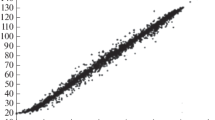Abstract
This paper deals with some important experiences gained from building an inverse neural model of a Linz-Donawitz (LD) steel converter. Steelmaking with an LD converter is a complex physico-chemical process where many variables have effects on the quality of the resulting steel. There are about 30 to 50 important, known input parameters of the process, the basic control parameter is the amount of oxygen used in the blasting, and there are two essentially important output parameters: the carbon content of the steel and its temperature at the end of the blasting. The purpose of our work is to build a reliable inverse model of the process helping the proper selection of the amount of oxygen for appropriate control. The work we have done until now is a feasibility study to see if neural models can result in practically applicable solutions.
Zusammenfassung
Dieser Beitrag befasst sich mit einigen wichtigen Erfahrungen, die beim Bau eines inversen neuronalen Modells des Linz-Donawitz-(LD-)Stahlkonverters gemacht wurden. Die Stahlherstellung mit einem LD-Konverter ist ein komplexes physikalisch-chemisches Verfahren, bei dem zahlreiche Variablen Auswirkungen auf die Qualität des entstehenden Stahls haben. So gibt es etwa 30 bis 50 wichtige bekannte Eingabeparamter. Der grundlegende Steuerparameter ist die beim Abblasen verbrauchte Sauerstoffmenge. Die zwei wesentlichen Ausgabeparameter sind der Kohlenstoffgehalt des Stahls und seine Temperatur nach Beendigung des Abblasens. Ziel dieser Arbeit ist die Entwicklung eines verlässlichen inversen Verfahrensmodells, das die richtige Sauerstoffmenge in einer geeigneten Regelung vorgibt. Bis jetzt wurde eine Machbarkeitsstudie erstellt, um festzustellen, ob neuronale Modelle in der Praxis anwendbare Lösungen herbeiführen können.
Similar content being viewed by others
References
He, X., Asada, H.: A new method for identifying orders of input-output models for nonlinear dynamic systems. Proc. of the American Control Conference 1993. San Francisco, CA, USA. pp. 2520–2523.
Narendra, K. S., Pathasarathy, K.: Identification and control of dynamical systems using neural networks. IEEE Trans. Neural Networks, Vol. 1. 1990, pp. 4–27.
Pataki, B., Horváth, G., Strausz, Gy.: Effects of database characteristics on the neural modeling of an industrial process. Proc. of NC’98 IFAC Symposium on Neural Computation, Vienna 1998, pp. 834–840.
Rissanen, J.: Modeling by shortest data description. Automatica, Vol. 14, pp. 465–471.
Strausz, Gy., Horváth, G., Pataki, B.: Experiences from the neural modeling of an industrial process. Proc. of EANN, Gibraltar 1998, pp. 213–220.
Akaike, H.: A new look at the statistical model identification. IEEE Transaction on Aut. Control, Vol. AC-19, No. 6, 1974, pp. 716–723.
Author information
Authors and Affiliations
Rights and permissions
About this article
Cite this article
Pataki, B., Horváth, G., Strausz, G. et al. Inverse neural modeling of a Linz-Donawitz steel converter. Elektrotech. Inftech. 117, 13–17 (2000). https://doi.org/10.1007/BF03161393
Published:
Issue Date:
DOI: https://doi.org/10.1007/BF03161393
Keywords
- neural modeling
- inverse modeling
- model order estimation
- steel industry
- data preprocessing
- knowledge extraction




